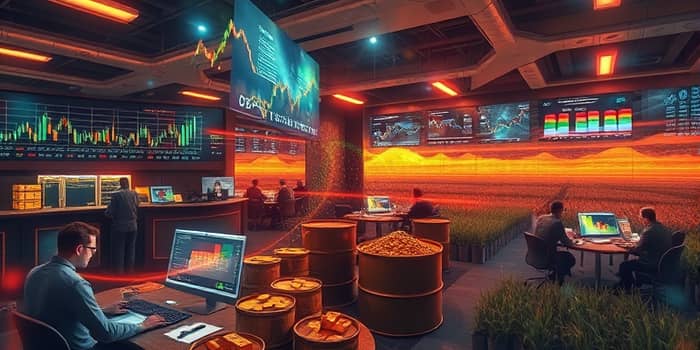
Commodity trading sits at the heart of global finance, linking producers of raw materials to consumers in every corner of the world. Market participants, from large institutions to individual speculators, rely on these exchanges to hedge, invest, and generate returns.
Understanding the forces behind volatile raw material price swings empowers traders to position themselves ahead of major shifts. In this article, we break down the causes of volatility and outline actionable strategies to capitalize on price movements.
Supply chain interruptions, natural disasters, and infrastructure failures can create sudden shortages. Historical examples include the 2011 Tohoku earthquake, which disrupted specialty pigments, and the 2011 Thailand floods that fueled a 57% increase in rubber prices. Such events often send shockwaves through related industries.
Geopolitical tensions—conflicts, sanctions, and trade disputes—also drive sharp price fluctuations. The Ukraine war, for instance, has escalated food and energy costs worldwide by constricting production and export routes.
Economic variables like inflation rates, currency movements, and central bank policies further complicate the picture. Rapid changes in interest rates or a weakening local currency can intensify commodity price swings, demanding agile responses from traders.
Successful traders combine multiple approaches to harness market momentum. The following strategies offer a blueprint for navigating raw material swings with discipline and precision.
Trend Trading relies on longer-term moving average strategies to identify sustained price directions. For example, energy commodities like crude oil often exhibit prolonged uptrends when supply constraints emerge, while precious metals may trend upwards during inflationary periods.
News-Based Trading exploits real-time information, such as satellite imagery of crop conditions or breaking geopolitical developments. By tracking weather forecasts and policy announcements, traders can anticipate shifts in agricultural and energy markets before prices fully adjust.
Price Action and Breakout Trading centers on identifying key support and resistance levels where supply and demand collide. When a breakout occurs with strong volume confirmation, it signals a high-probability entry point for capturing rapid price movements.
Technical Indicators offer objective entry and exit signals. Below is a summary of commonly used indicators:
Traders often combine these tools to validate signals, improving the reliability of entries and exits in dynamic markets.
Mitigating losses is as crucial as pursuing profits. A comprehensive risk management approach integrates credit, operational, and market exposures into every trading decision.
Implementing trade credit insurance to mitigate counterparty risks ensures that defaults or payment delays do not derail overall performance. Regular stress testing across adverse scenarios, from supply chain breakdowns to extreme price swings, further fortifies a portfolio against unexpected shocks.
Innovation is reshaping commodity trading infrastructure. Firms investing in automation and AI witness optimization of logistics and trading operations, accelerating execution and reducing human error.
Emerging applications of quantum computing in trading execution promise to solve complex optimization problems, such as route planning for physical deliveries or large-scale portfolio rebalancing, in a fraction of the time required by classical algorithms.
Adopting these technologies early can deliver a substantial edge, streamlining back-office tasks and enabling real-time risk assessment across vast datasets.
Commodity markets face both headwinds and tailwinds. Rising production costs and increased competition have squeezed margins in recent years, but volatility also creates opportunities for agile traders.
Future trends may include tighter environmental regulations, growing demand for sustainable raw materials, and enhanced data-sharing platforms facilitating transparency. Staying ahead requires continuous learning and adaptability to a rapidly evolving landscape.
Mastering commodity trading demands a holistic understanding of the forces driving volatile raw material price swings and a disciplined application of proven strategies. From trend following to breakout trading and cutting-edge technology, each element plays a vital role in building a robust trading blueprint.
By incorporating rigorous risk management, leveraging innovative tools, and remaining vigilant about global developments, traders can position themselves to profit from raw material swings and thrive in the dynamic arena of commodity markets.
References













